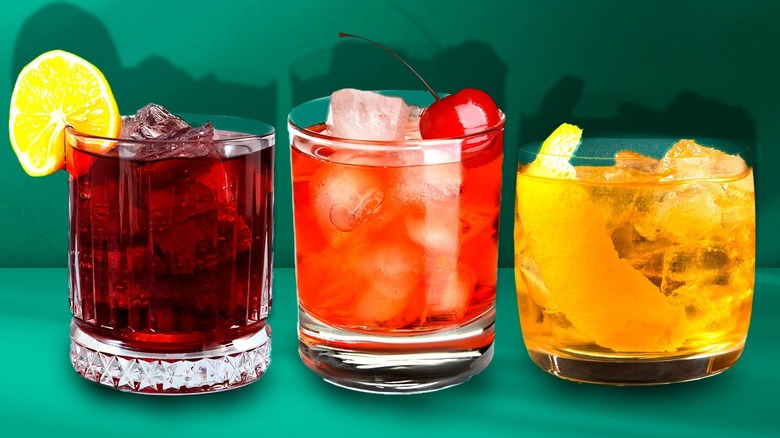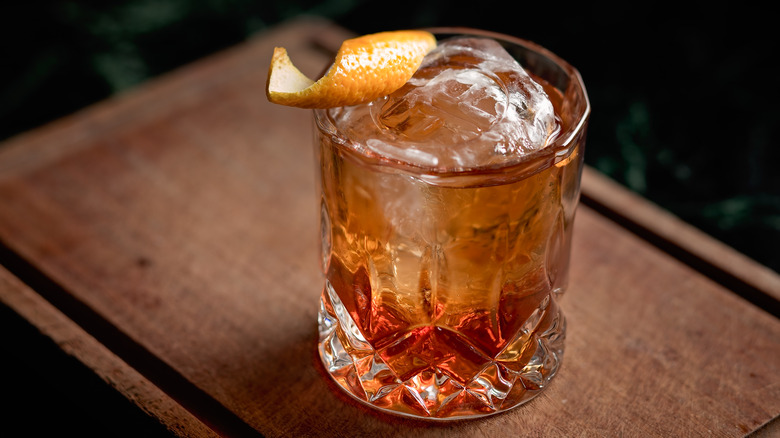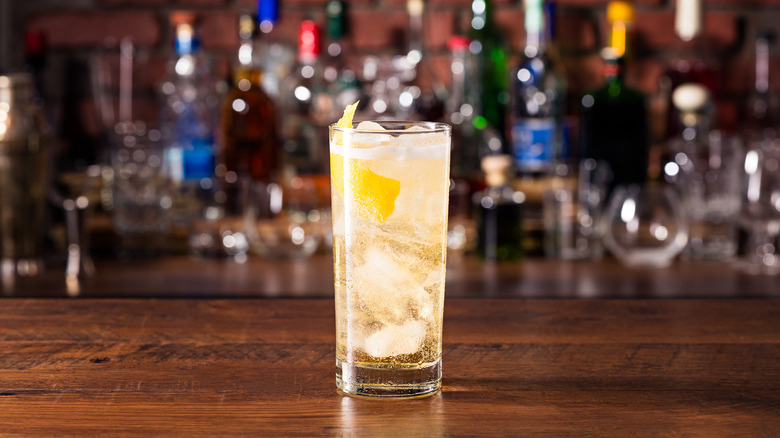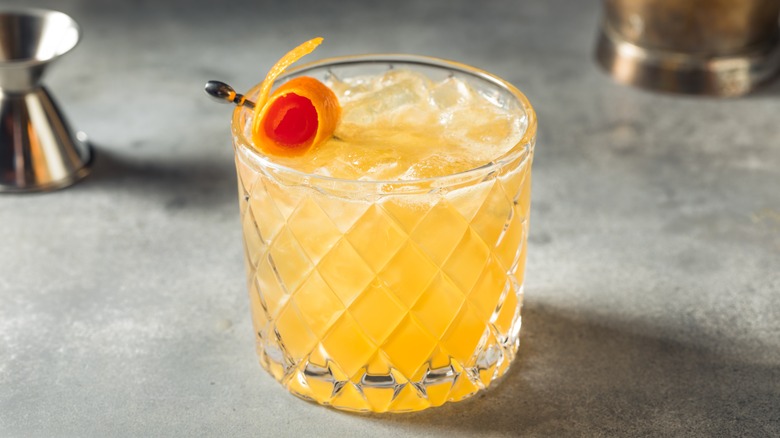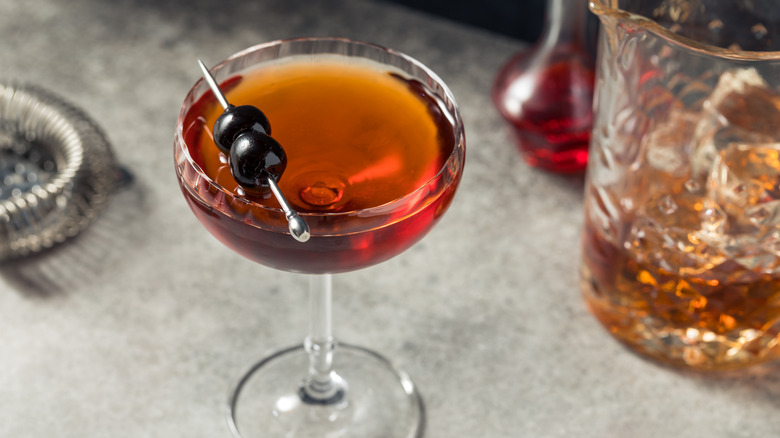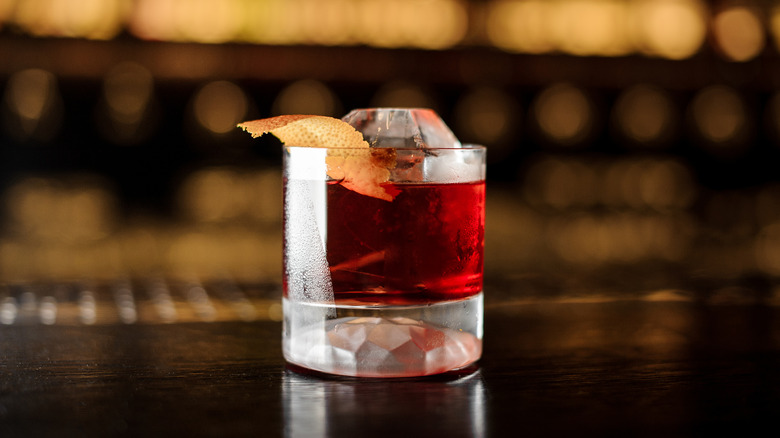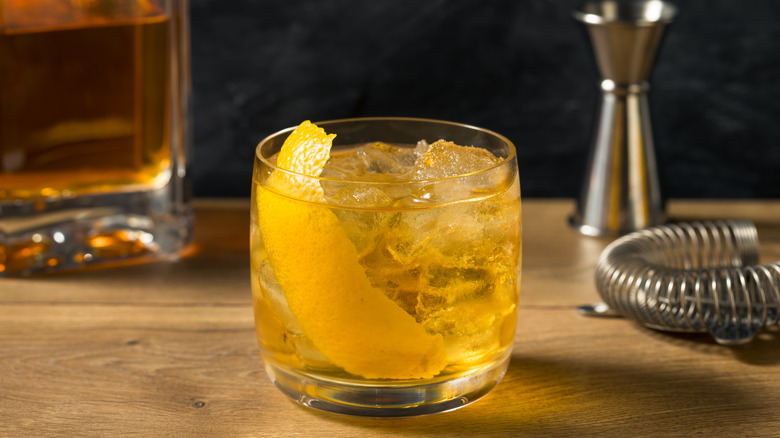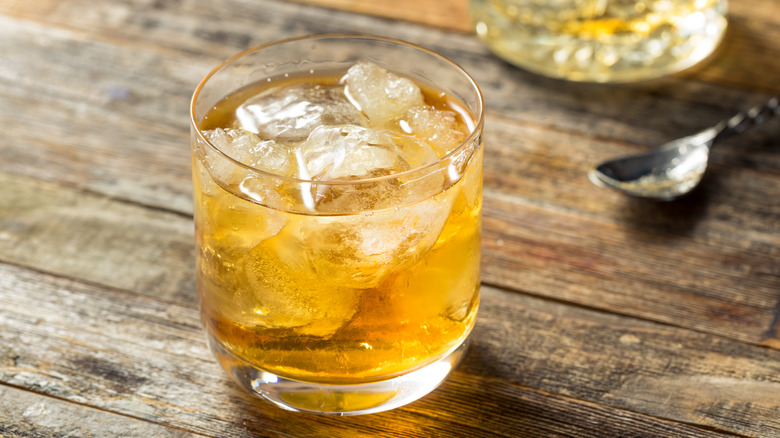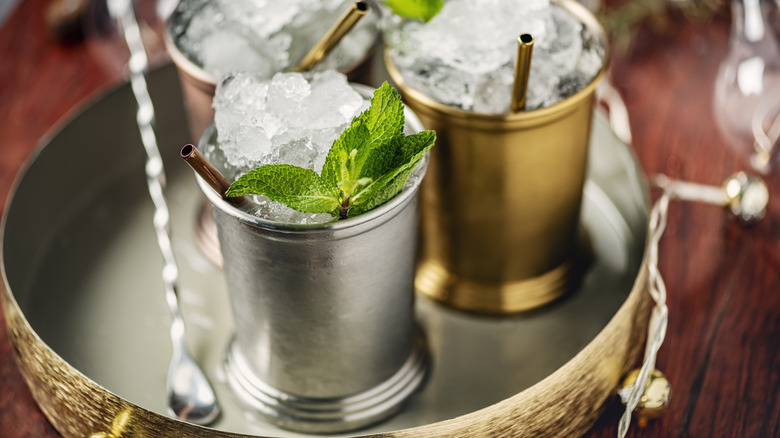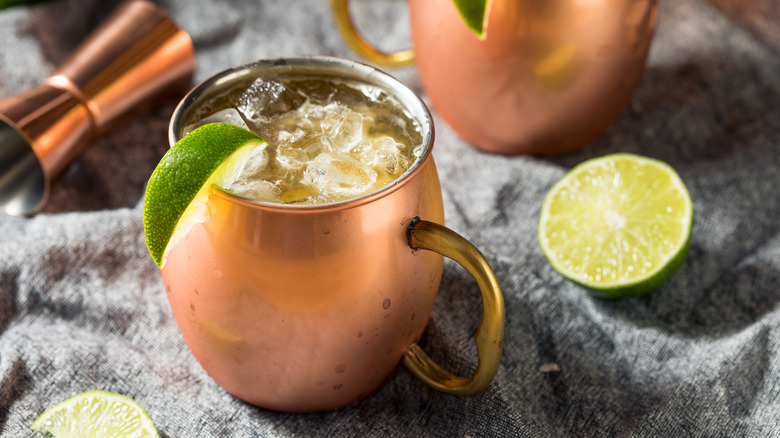A Mixologist Offers 10 Simple Whiskey Cocktails To Make With Only 3 Ingredients
As bartenders worldwide create increasingly unique cocktails to delight and impress drinkers, a misconception has developed. Mixologists continue to experiment with novel ingredients and techniques, some of which wouldn't be out of place in a laboratory, leading us to believe that the more complex a cocktail is, the better it will taste.
While some of these complicated concoctions are genuinely delicious, one only needs to look at a list of classic cocktails to see that the majority of them have one thing in common — they're surprisingly simple. Many of the most beloved cocktails contain just a handful of ingredients, and the old-school favorites tend to use base spirits that have been ubiquitous for centuries. Gin and rum are particularly popular, but whiskey is one of the most common cocktail liquors.
I spent over a decade working and managing at a wide variety of cocktail bars around the world — some with seemingly unlimited budgets, others with barely enough shelf space for the basic spirits. This experience taught me that even with a relatively sparse inventory, it's possible to craft a solid array of cocktails while saving both space and money. Not everyone has room for a packed bar, but this shouldn't hold back lovers of whiskey cocktails or bartenders with limited supplies. I've compiled a list of world-class whiskey cocktails that you can whip up with minimal experience, few specialist tools, and only three simple-to-source ingredients.
Old fashioned
First up, we have the old fashioned, a cocktail so synonymous with whiskey that, once upon a time, it was known simply as the whiskey cocktail. The classic old fashioned cocktail recipe is extremely straightforward, only requiring a little sugar, a few dashes of bitters, and, of course, a healthy measure of your favorite whiskey.
Typically, the old fashioned calls for bourbon, America's famous corn-based whiskey. The liquor's inherent sweetness makes the cocktail more palatable while contrasting the astringency of the bitters, but the beauty of the old fashioned is its versatility. If you prefer your drink with a little more kick, you can swap the bourbon for rye, and there are plenty of takes on the old fashioned that eschew whiskey altogether in favor of dark rum or aged tequila. The same goes for the bitters. Although Angostura bitters tend to be the tincture of choice, you can substitute them for another type of bitters to highlight different characteristics of the base spirit.
Making an old fashioned is as simple as the ingredients list. The preferred method involves using a mixing glass, but you can always build the cocktail directly in a rocks glass. Just add a teaspoon of sugar or a sugar cube to the glass along with a couple dashes of bitters and about 2 ounces of bourbon. Then add a handful of ice cubes and stir the mixture until the sugar has completely dissolved, and the cocktail is diluted to your preferred strength.
Whiskey highball
Of all the cocktails in this article, the whiskey highball is arguably the easiest to put together. Consisting of only whiskey and sparkling soda water over ice, and a wedge of fresh lemon or lime, the highball is the embodiment of elegance.
You'd be forgiven for asking if there's a difference between a highball and a whiskey soda, and the answer is something that's been hotly debated. Most in the cocktail industry agree that it comes down to the level of care and craftsmanship put into making the drink. This is a big part of why the highball is so popular in Japan, where mixologists craft the cocktail as an art form.
The highball is a way to enjoy the more delicate aspects of whiskey, with the soda water reducing the harsher elements of the spirit. The soda's effervescence is a key aspect of the cocktail, which is why your choice of water is especially important. You want a soda that maintains its sparkle without going flat before you finish your drink — but at the same time, you should avoid over-carbonated options with coarse, sharp bubbles that overpower the whiskey. The recipe requires what's known as a highball glass, which is a tall, narrow vessel with straight sides. Fill the glass with ice, then pour in 2 parts soda and 1 part whiskey; the trick is to gently mix the ingredients to avoid killing the carbonation by over-stirring. You can garnish the cocktail with your citrus of choice.
Whiskey sour
A zingy whiskey sour is the perfect example of how it's possible to create a cocktail that tastes both refreshing and complex while containing just a few basic ingredients. All you need is whiskey, fresh lemon juice to introduce the sour element, and simple syrup to balance out the tartness.
Making a simple syrup recipe is as easy as the name implies, as it's just one part sugar dissolved in one part water. Once the syrup is ready, you can decant it into a spare bottle for use in all manner of cocktails. In terms of the spirit, bourbon is considered to be best for a whiskey sour, but there are plenty of other excellent whiskeys that are suitable, each bringing their own unique qualities to the cocktail.
When you're ready, grab yourself a cocktail shaker filled with ice, and add 2 ounces of whiskey, an ounce of fresh lemon juice, and an ounce of simple syrup. You can always adjust these amounts based on your personal tastes, depending on whether you prefer a sweeter or more sour cocktail. Give the ingredients a good shake until they're fully combined, and so the ice can chill and dilute the liquid within, then strain into a rocks glass over ice. If you're feeling fancy, you can also add an egg white to the shaker to give your sour a frothy, creamy texture, and a few dashes of your favorite bitters to further boost the cocktail's flavors.
Manhattan
There are few drinks as iconic as this rye-based tipple, and while it's hard to pin down the Manhattan cocktail's true origin, that hasn't stopped it from remaining a fan favorite for over a century. Three ingredients is all it takes to create a rich, boozy concoction that oozes charm and sophistication.
The classic Manhattan recipe calls for rye whiskey as a base spirit. While bourbon or Canadian whisky will do the trick, rye has a more powerful, spicy profile. These characteristics are important because the whiskey needs to stand up to the next ingredient down the list — sweet vermouth. Fortified with sugar, herbs, and extra alcohol, sweet vermouth is a fortified wine with roots stretching back to Turin, Italy, in the late 18th century. Like many alcoholic beverages of the era, it was first promoted as a medicinal remedy, before finding popularity as an aperitif. When vermouth finally made its way over to America in the 19th century, it wasn't long before bartenders experimented with the concoction, and we can thank one of those mixologists for the Manhattan.
To make a Manhattan at home, pour 2 ounces of rye and an ounce of sweet vermouth into a mixing glass filled with ice, then add a couple dashes of Angostura bitters to tie the flavors together. Next, stir the ingredients until they're well-mixed and diluted to the appropriate strength. Finally, strain the liquid into a coupe cocktail glass, using a fine mesh strainer to filter out any remaining ice.
Rob Roy
There's a common technique in the realm of mixology: to "Mr. Potato Head" a cocktail. The name refers to the idea of taking the template of an existing cocktail and replacing certain components to create a brand-new drink, which is how we ended up with the Rob Roy.
The recipe is identical to the Manhattan. However, what makes a Rob Roy cocktail different from a Manhattan is that rather than rye whiskey, a Rob Roy calls for Scotch whisky instead. The Scotch substitution is what inspired the cocktail's name — an appropriate homage to Rob Roy MacGregor, a Scottish outlaw and folk hero. In terms of which came first, the history is debatable, but it's widely believed that the Rob Roy was created at New York City's Waldorf Astoria hotel in the 1890s, over a decade after the Manhattan appeared.
For Scotch lovers, the Rob Roy is a perfect alternative, displaying smokier and maltier characteristics, but the wider variety of Scotch styles means some varieties work better than others. The whiskies to avoid are those of a peatier nature — a little smoke is fine, but peat bombs (like Scotches from Islay distilleries) can overwhelm the vermouth. Making a Rob Roy is just as straightforward as mixing up a Manhattan, prepared with the same ratios that you can adjust to your tastes. Add the whisky and vermouth to a mixing glass with fresh ice and a couple dashes of Angostura bitters, stir until diluted, and strain into a cocktail glass.
Boulevardier
Upon hearing the recipe, one would be forgiven for thinking a Boulevardier was merely a twist on the more popular Negroni cocktail. However, despite consisting of equal parts Campari, sweet vermouth, and bourbon whiskey — as opposed to the Negroni's gin — the Boulevardier cocktail's history was developed independently.
Attributed to an American expat living in Paris in the 1920s, free from his homeland's Prohibition era, the Boulevardier still retains the best features of a Negroni. The strikingly bitter Campari and fruity sweet vermouth are still an integral part of the cocktail's makeup. However, changing the base spirit from gin to bourbon adds a slightly sweeter element to the drink while reducing its more herbaceous qualities. Because bourbon tends to have a less pronounced flavor profile than gin, many bartenders will slightly adjust the 1:1:1 ingredients ratio by increasing the amount of whiskey.
There are plenty of excellent bourbons for a Boulevardier, but the key is choosing one that aligns with your preferred tastes. In general, high-rye bourbons have more of a spicy kick that can stand up against the cocktail's other ingredients, but feel free to choose a corn- or wheat-forward whiskey for a sweeter, smoother profile to temper the astringent Campari. Making a Boulevardier is incredibly simple — just stir your ingredients with ice until chilled and diluted. Some folks prefer theirs on the rocks, like a Negroni, but you can also strain it into a coupe to enjoy it straight up.
Rusty nail
The rusty nail is an incredibly straightforward cocktail that tempers fiery Scotch with a Scotch-based liqueur, Drambuie, simultaneously amplifying the whisky's flavors while imbuing it with a sweet, mellow spice. For the whisky, you can choose whichever is your favorite — you can even opt for higher-end drams, if that's your thing, because the simplicity of the drink means its quality won't be lost in the final cocktail.
As for the Drambuie? There are no substitutes. The unique nature of the liqueur comes from the fact its precise recipe is a closely guarded secret, with the bottle declaring the contents to be aged Scotch whisky, heather honey, and unspecified herbs and spices. The legend of Drambuie tells us that the drink can be traced back to the 18th century, when it was said to be an elixir consumed by Bonnie Prince Charlie.
According to Drambuie management, only three people alive today know its true recipe. The flavor of Drambuie liqueur is hard to compare to any other potent potable. Besides the familiar notes of aged Scotch, you'll notice a honeyed sweetness, notes of clove and anise, and general herbaceous tastes. For a Scotch-forward rusty nail, mix 2 parts whisky and 1 part Drambuie over an ice-filled rocks glass and stir, then garnish with a twist of zesty lemon to cut through the cocktail's sweeter elements.
Godfather
Named after Francis Ford Coppola's iconic movie, the Godfather cocktail first hit bars during the 1970s. It shares a template with the rusty nail, consisting of Scotch whisky, a liqueur, and a citrus twist, but it's generally sweeter and more approachable than its predecessor.
Instead of Drambuie, the Godfather uses amaretto, a bittersweet Italian liqueur that boasts strong notes of almond. However, despite its flavor, amaretto typically contains no nuts whatsoever, achieving this taste profile from apricot kernels instead. The smoky, toffee-like qualities of Scotch pair perfectly with the rich amaretto, which in turn balances out the harsher elements of the base spirit.
Despite only consisting of three ingredients, the Godfather is another cocktail that offers remarkable versatility, as you can change the style of the Scotch and the ratios of the two liquid ingredients to tailor the drink to your preference. Although some recipes call for a 2:1 ratio of Scotch to amaretto, this gives the cocktail a sweet, dessert-like profile, so you may want to lower the amount of the liqueur if you're after a drier, whisky-forward tipple. The mixing technique for a Godfather is identical to the rusty nail — stir the Scotch and amaretto over ice in a rocks glass until chilled and diluted, then garnish with an orange peel to bring out the dried fruit flavors present in the base spirits.
Mint julep
Today, the mint julep is most commonly associated with the Kentucky Derby, thanks to its status as the event's official drink since the 1930s. Technically, however, the mint julep's history predates the celebrated horse race, and its earliest iterations came from Virginia.
Originally made with sugar, mint, and low-quality rum, the drink improved over time. The increased availability of ice made the cocktail more palatable, and bourbon eventually became the spirit of choice. Now, the mint julep has a well-earned reputation for being an extremely refreshing beverage, typically served in a metallic cup. Despite the recipe changing over the years, it's still just as straightforward as it was in the early days, requiring only bourbon, sugar, and fresh mint.
Although any bourbon will do, Woodford Reserve is arguably the most popular choice, as it's the official whiskey of the Kentucky Derby, and its oaky, fruit-forward profile is a great match for the mint. The type of mint you use in a julep actually matters, as well — peppermint tends to be too sharp in its coolness, while spearmint is more appropriate thanks to its sweeter, more delicate nature. To whip up a mint julep, start by gently muddling the mint in the bottom of a julep cup, being careful not to press too hard, as this can create an astringent flavor. Add the sugar and 2 ounces of bourbon, fill the cup with crushed ice, then gently stir the cocktail until the outside of the metal vessel frosts up.
Kentucky mule
You may already be familiar with the Moscow mule, a classic cocktail that deftly combines vodka and spicy ginger beer, cut with fresh, citrusy lime juice, and served in a stylish copper mug. As you can probably guess, the Kentucky mule swaps vodka for bourbon, resulting in a cocktail with a whiskey twist that remains equally refreshing.
Using bourbon in a mule cocktail gives it a sweeter profile, and offers a wider and richer range of flavors expected from the whiskey. Although rye whiskey works as well, its inherent spice is amplified by the fiery ginger, so you may want to avoid this unless you prefer a more intense drink. In regards to the copper mug, its purpose is twofold. First, the metal vessel helps to insulate the liquid within, keeping it colder for longer, which is especially handy if you're enjoying your mule on a hot summer's day. The second reason is that, according to some bar professionals, the copper oxidizes when it comes in contact with alcohol, enhancing the aromas and flavors of the beverage.
That said, if you don't happen to have a copper mule mug, a rocks glass or highball will do the trick. Whichever option you pick, pour in 2 ounces of your favorite bourbon and about half an ounce of fresh lime juice. Next, fill the cup with ice, top it off with your preferred ginger beer, and stir your ingredients until they're fully combined, and the cocktail becomes sufficiently cold.
